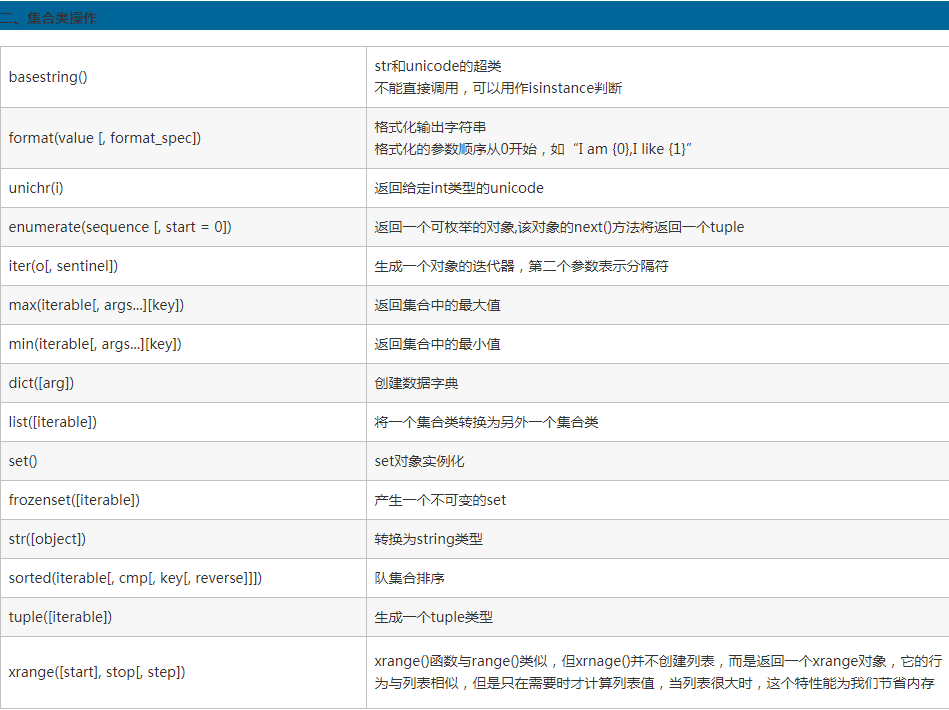什么是python内置函数 |
您所在的位置:网站首页 › 说明python中内置函数的运用 › 什么是python内置函数 |
什么是python内置函数
|
python的内置函数截止到python版本3.6.2,现在python一共为我们提供了68个内置函数。它们就是python提供给你直接可以拿来使用的所有函数。那今天我们就一起来认识一下python的内置函数。 为了方便记忆,已经有很多开发者将这些内置函数进行了如下分类: ·数学运算(7个) ·类型转换(24个) ·序列操作(8个) ·对象操作(7个) ·反射操作(8个) ·变量操作(2个) ·交互操作(2个) ·文件操作(1个) ·编译执行(4个) ·装饰器(3个) 接下来看看具体每个类别里包含了那些内置函数:
相关推荐:《Python视频教程》 具体每个函数的解析如下: 数学运算 ·abs:求数值的绝对值 >>> abs(-2) 2·divmod:返回两个数值的商和余数 >>> divmod(5,2) (2, 1) >> divmod(5.5,2) (2.0, 1.5)·max:返回可迭代对象中的元素中的最大值或者所有参数的最大值 >>> max(1,2,3) # 传入3个参数 取3个中较大者 3 >>> max('1234') # 传入1个可迭代对象,取其最大元素值 '4' >>> max(-1,0) # 数值默认取数值较大者 0 >>> max(-1,0,key = abs) # 传入了求绝对值函数,则参数都会进行求绝对值后再取较大者 -1·min:返回可迭代对象中的元素中的最小值或者所有参数的最小值 >>> min(1,2,3) # 传入3个参数 取3个中较小者 1 >>> min('1234') # 传入1个可迭代对象,取其最小元素值 '1' >>> min(-1,-2) # 数值默认去数值较小者 -2 >>> min(-1,-2,key = abs) # 传入了求绝对值函数,则参数都会进行求绝对值后再取较小者 -1·pow:返回两个数值的幂运算值或其与指定整数的模值 >>> pow(2,3) >>> 2**3 >>> pow(2,3,5) >>> pow(2,3)%5·round:对浮点数进行四舍五入求值 >>> round(1.1314926,1) 1.1 >>> round(1.1314926,5) 1.13149·sum:对元素类型是数值的可迭代对象中的每个元素求和 # 传入可迭代对象 >>> sum((1,2,3,4)) 10 # 元素类型必须是数值型 >>> sum((1.5,2.5,3.5,4.5)) 12.0 >>> sum((1,2,3,4),-10) 0类型转换 ·bool:根据传入的参数的逻辑值创建一个新的布尔值 >>> bool() #未传入参数 False >>> bool(0) #数值0、空序列等值为False False >>> bool(1) True·int:根据传入的参数创建一个新的整数 >>> int() #不传入参数时,得到结果0。 0 >>> int(3) 3 >>> int(3.6) 3·float:根据传入的参数创建一个新的浮点数 >>> float() #不提供参数的时候,返回0.0 0.0 >>> float(3) 3.0 >>> float('3') 3.0·complex:根据传入参数创建一个新的复数 >>> complex() #当两个参数都不提供时,返回复数 0j。 0j >>> complex('1 2j') #传入字符串创建复数 (1 2j) >>> complex(1,2) #传入数值创建复数 (1 2j)·str:返回一个对象的字符串表现形式(给用户) >>> str() '' >>> str(None) 'None' >>> str('abc') 'abc' >>> str(123) '123'·bytearray:根据传入的参数创建一个新的字节数组 >>> bytearray('中文','utf-8') bytearray(b'\xe4\xb8\xad\xe6\x96\x87')·bytes:根据传入的参数创建一个新的不可变字节数组 >>> bytes('中文','utf-8') b'\xe4\xb8\xad\xe6\x96\x87'·memoryview:根据传入的参数创建一个新的内存查看对象 >>> v = memoryview(b'abcefg') >>> v[1] 98 >>> v[-1] 103·ord:返回Unicode字符对应的整数 >>> ord('a') 97·chr:返回整数所对应的Unicode字符 >>> chr(97) #参数类型为整数 'a'·bin:将整数转换成2进制字符串 >>> bin(3) '0b11'·oct:将整数转化成8进制数字符串 >>> oct(10) '0o12'·hex:将整数转换成16进制字符串 >>> hex(15) '0xf'·tuple:根据传入的参数创建一个新的元组 >>> tuple() #不传入参数,创建空元组 () >>> tuple('121') #传入可迭代对象。使用其元素创建新的元组 ('1', '2', '1')·list:根据传入的参数创建一个新的列表 >>>list() # 不传入参数,创建空列表 [] >>> list('abcd') # 传入可迭代对象,使用其元素创建新的列表 ['a', 'b', 'c', 'd']·dict:根据传入的参数创建一个新的字典 >>> dict() # 不传入任何参数时,返回空字典。 {} >>> dict(a = 1,b = 2) # 可以传入键值对创建字典。 {'b': 2, 'a': 1} >>> dict(zip(['a','b'],[1,2])) # 可以传入映射函数创建字典。 {'b': 2, 'a': 1} >>> dict((('a',1),('b',2))) # 可以传入可迭代对象创建字典。 {'b': 2, 'a': 1}·set:根据传入的参数创建一个新的集合 >>>set() # 不传入参数,创建空集合 set() >>> a = set(range(10)) # 传入可迭代对象,创建集合 >>> a {0, 1, 2, 3, 4, 5, 6, 7, 8, 9}·frozenset:根据传入的参数创建一个新的不可变集合 >>> a = frozenset(range(10)) >>> a frozenset({0, 1, 2, 3, 4, 5, 6, 7, 8, 9})·enumerate:根据可迭代对象创建枚举对象 >>> seasons = ['Spring', 'Summer', 'Fall', 'Winter'] >>> list(enumerate(seasons)) [(0, 'Spring'), (1, 'Summer'), (2, 'Fall'), (3, 'Winter')] >>> list(enumerate(seasons, start=1)) #指定起始值 [(1, 'Spring'), (2, 'Summer'), (3, 'Fall'), (4, 'Winter')]·range:根据传入的参数创建一个新的range对象 >>> a = range(10) >>> b = range(1,10) >>> c = range(1,10,3) >>> a,b,c # 分别输出a,b,c (range(0, 10), range(1, 10), range(1, 10, 3)) >>> list(a),list(b),list(c) # 分别输出a,b,c的元素 ([0, 1, 2, 3, 4, 5, 6, 7, 8, 9], [1, 2, 3, 4, 5, 6, 7, 8, 9], [1, 4, 7]) >>>·iter:根据传入的参数创建一个新的可迭代对象 >>> a = iter('abcd') #字符串序列 >>> a >>> next(a) 'a' >>> next(a) 'b' >>> next(a) 'c' >>> next(a) 'd' >>> next(a) Traceback (most recent call last): File "", line 1, in next(a) StopIteration·slice:根据传入的参数创建一个新的切片对象 >>> c1 = slice(5) # 定义c1 >>> c1 slice(None, 5, None) >>> c2 = slice(2,5) # 定义c2 >>> c2 slice(2, 5, None) >>> c3 = slice(1,10,3) # 定义c3 >>> c3 slice(1, 10, 3)·super:根据传入的参数创建一个新的子类和父类关系的代理对象 #定义父类A >>> class A(object): def __init__(self): print('A.__init__') #定义子类B,继承A >>> class B(A): def __init__(self): print('B.__init__') super().__init__() #super调用父类方法 >>> b = B() B.__init__ A.__init__·object:创建一个新的object对象 >>> a = object() >>> a.name = 'kim' # 不能设置属性 Traceback (most recent call last): File "", line 1, in a.name = 'kim' AttributeError: 'object' object has no attribute 'name'序列操作 ·all:判断可迭代对象的每个元素是否都为True值 >>> all([1,2]) #列表中每个元素逻辑值均为True,返回True True >>> all([0,1,2]) #列表中0的逻辑值为False,返回False False >>> all(()) #空元组 True >>> all({}) #空字典 True·any:判断可迭代对象的元素是否有为True值的元素 >>> any([0,1,2]) #列表元素有一个为True,则返回True True >>> any([0,0]) #列表元素全部为False,则返回False False >>> any([]) #空列表 False >>> any({}) #空字典 False·filter:使用指定方法过滤可迭代对象的元素 >>> a = list(range(1,10)) #定义序列 >>> a [1, 2, 3, 4, 5, 6, 7, 8, 9] >>> def if_odd(x): #定义奇数判断函数 return x%2==1 >>> list(filter(if_odd,a)) #筛选序列中的奇数 [1, 3, 5, 7, 9]·map:使用指定方法去作用传入的每个可迭代对象的元素,生成新的可迭代对象 >>> a = map(ord,'abcd') >>> a >>> list(a) [97, 98, 99, 100]·next:返回可迭代对象中的下一个元素值 >>> a = iter('abcd') >>> next(a) 'a' >>> next(a) 'b' >>> next(a) 'c' >>> next(a) 'd' >>> next(a) Traceback (most recent call last): File "", line 1, in next(a) StopIteration #传入default参数后,如果可迭代对象还有元素没有返回,则依次返回其元素值,如果所有元素已经返回,则返回default指定的 默认值而不抛出StopIteration 异常 >>> next(a,'e') 'e' >>> next(a,'e') 'e'·reversed:反转序列生成新的可迭代对象 >>> a = reversed(range(10)) # 传入range对象 >>> a # 类型变成迭代器 >>> list(a) [9, 8, 7, 6, 5, 4, 3, 2, 1, 0]·sorted:对可迭代对象进行排序,返回一个新的列表 >>> a = ['a','b','d','c','B','A'] >>> a ['a', 'b', 'd', 'c', 'B', 'A'] >>> sorted(a) # 默认按字符ascii码排序 ['A', 'B', 'a', 'b', 'c', 'd'] >>> sorted(a,key = str.lower) # 转换成小写后再排序,'a'和'A'值一样,'b'和'B'值一样 ['a', 'A', 'b', 'B', 'c', 'd']·zip:聚合传入的每个迭代器中相同位置的元素,返回一个新的元组类型迭代器 >>> x = [1,2,3] #长度3 >>> y = [4,5,6,7,8] #长度5 >>> list(zip(x,y)) # 取最小长度3 [(1, 4), (2, 5), (3, 6)]对象操作 ·help:返回对象的帮助信息 >>> help(str) Help on class str in module builtins: class str(object) | str(object='') -> str | str(bytes_or_buffer[, encoding[, errors]]) -> str | | Create a new string object from the given object. If encoding or | errors is specified, then the object must expose a data buffer | that will be decoded using the given encoding and error handler. | Otherwise, returns the result of object.__str__() (if defined) | or repr(object). | encoding defaults to sys.getdefaultencoding(). | errors defaults to 'strict'. | | Methods defined here: | | __add__(self, value, /) | Return self value. | ***************************·dir:返回对象或者当前作用域内的属性列表 >>> import math >>> math >>> dir(math) ['__doc__', '__loader__', '__name__', '__package__', '__spec__', 'acos', 'acosh', 'asin', 'asinh', 'atan', 'atan2', 'atanh', 'ceil', 'copysign', 'cos', 'cosh', 'degrees', 'e', 'erf', 'erfc', 'exp', 'expm1', 'fabs', 'factorial', 'floor', 'fmod', 'frexp', 'fsum', 'gamma', 'gcd', 'hypot', 'inf', 'isclose', 'isfinite', 'isinf', 'isnan', 'ldexp', 'lgamma', 'log', 'log10', 'log1p', 'log2', 'modf', 'nan', 'pi', 'pow', 'radians', 'sin', 'sinh', 'sqrt', 'tan', 'tanh', 'trunc']·id:返回对象的唯一标识符 >>> a = 'some text' >>> id(a) 69228568 hash:获取对象的哈希值 >>> hash('good good study') 1032709256·type:返回对象的类型,或者根据传入的参数创建一个新的类型 >>> type(1) # 返回对象的类型 #使用type函数创建类型D,含有属性InfoD >>> D = type('D',(A,B),dict(InfoD='some thing defined in D')) >>> d = D() >>> d.InfoD 'some thing defined in D'·len:返回对象的长度 >>> len('abcd') # 字符串 >>> len(bytes('abcd','utf-8')) # 字节数组 >>> len((1,2,3,4)) # 元组 >>> len([1,2,3,4]) # 列表 >>> len(range(1,5)) # range对象 >>> len({'a':1,'b':2,'c':3,'d':4}) # 字典 >>> len({'a','b','c','d'}) # 集合 >>> len(frozenset('abcd')) #不可变集合·ascii:返回对象的可打印表字符串表现方式 >>> ascii(1) '1' >>> ascii('&') "'&'" >>> ascii(9000000) '9000000' >>> ascii('中文') #非ascii字符 "'\\u4e2d\\u6587'"·format:格式化显示值 #字符串可以提供的参数 's' None >>> format('some string','s') 'some string' >>> format('some string') 'some string' #整形数值可以提供的参数有 'b' 'c' 'd' 'o' 'x' 'X' 'n' None >>> format(3,'b') #转换成二进制 '11' >>> format(97,'c') #转换unicode成字符 'a' >>> format(11,'d') #转换成10进制 '11' >>> format(11,'o') #转换成8进制 '13' >>> format(11,'x') #转换成16进制 小写字母表示 'b' >>> format(11,'X') #转换成16进制 大写字母表示 'B' >>> format(11,'n') #和d一样 '11' >>> format(11) #默认和d一样 '11' #浮点数可以提供的参数有 'e' 'E' 'f' 'F' 'g' 'G' 'n' '%' None >>> format(314159267,'e') #科学计数法,默认保留6位小数 '3.141593e 08' >>> format(314159267,'0.2e') #科学计数法,指定保留2位小数 '3.14e 08' >>> format(314159267,'0.2E') #科学计数法,指定保留2位小数,采用大写E表示 '3.14E 08' >>> format(314159267,'f') #小数点计数法,默认保留6位小数 '314159267.000000' >>> format(3.14159267000,'f') #小数点计数法,默认保留6位小数 '3.141593' >>> format(3.14159267000,'0.8f') #小数点计数法,指定保留8位小数 '3.14159267' >>> format(3.14159267000,'0.10f') #小数点计数法,指定保留10位小数 '3.1415926700' >>> format(3.14e 1000000,'F') #小数点计数法,无穷大转换成大小字母 'INF' #g的格式化比较特殊,假设p为格式中指定的保留小数位数,先尝试采用科学计数法格式化,得到幂指数exp,如果-4> format(0.00003141566,'.1g') #p=1,exp=-5 ==》 -4> format(0.00003141566,'.2g') #p=1,exp=-5 ==》 -4> format(0.00003141566,'.3g') #p=1,exp=-5 ==》 -4> format(0.00003141566,'.3G') #p=1,exp=-5 ==》 -4> format(3.1415926777,'.1g') #p=1,exp=0 ==》 -4> format(3.1415926777,'.2g') #p=1,exp=0 ==》 -4> format(3.1415926777,'.3g') #p=1,exp=0 ==》 -4> format(0.00003141566,'.1n') #和g相同 '3e-05' >>> format(0.00003141566,'.3n') #和g相同 '3.14e-05' >>> format(0.00003141566) #和g相同 '3.141566e-05'·vars:返回当前作用域内的局部变量和其值组成的字典,或者返回对象的属性列表 #作用于类实例 >>> class A(object): pass >>> a.__dict__ {} >>> vars(a) {} >>> a.name = 'Kim' >>> a.__dict__ {'name': 'Kim'} >>> vars(a) {'name': 'Kim'}反射操作 ·__import__:动态导入模块 index = __import__('index') index.sayHello()·isinstance:判断对象是否是类或者类型元组中任意类元素的实例 >>> isinstance(1,int) True >>> isinstance(1,str) False >>> isinstance(1,(int,str)) True·issubclass:判断类是否是另外一个类或者类型元组中任意类元素的子类 >>> issubclass(bool,int) True >>> issubclass(bool,str) False >>> issubclass(bool,(str,int)) True·hasattr:检查对象是否含有属性 #定义类A >>> class Student: def __init__(self,name): self.name = name >>> s = Student('Aim') >>> hasattr(s,'name') #a含有name属性 True >>> hasattr(s,'age') #a不含有age属性 False·getattr:获取对象的属性值 #定义类Student >>> class Student: def __init__(self,name): self.name = name >>> getattr(s,'name') #存在属性name 'Aim' >>> getattr(s,'age',6) #不存在属性age,但提供了默认值,返回默认值 >>> getattr(s,'age') #不存在属性age,未提供默认值,调用报错 Traceback (most recent call last): File "", line 1, in getattr(s,'age') AttributeError: 'Stduent' object has no attribute 'age'·setattr:设置对象的属性值 >>> class Student: def __init__(self,name): self.name = name >>> a = Student('Kim') >>> a.name 'Kim' >>> setattr(a,'name','Bob') >>> a.name 'Bob'·delattr:删除对象的属性 #定义类A >>> class A: def __init__(self,name): self.name = name def sayHello(self): print('hello',self.name) #测试属性和方法 >>> a.name '小麦' >>> a.sayHello() hello 小麦 #删除属性 >>> delattr(a,'name') >>> a.name Traceback (most recent call last): File "", line 1, in a.name AttributeError: 'A' object has no attribute 'name'·callable:检测对象是否可被调用 >>> class B: #定义类B def __call__(self): print('instances are callable now.') >>> callable(B) #类B是可调用对象 True >>> b = B() #调用类B >>> callable(b) #实例b是可调用对象 True >>> b() #调用实例b成功 instances are callable now.变量操作 ·globals:返回当前作用域内的全局变量和其值组成的字典 >>> globals() {'__spec__': None, '__package__': None, '__builtins__': , '__name__': '__main__', '__doc__': None, '__loader__': } >>> a = 1 >>> globals() #多了一个a {'__spec__': None, '__package__': None, '__builtins__': , 'a': 1, '__name__': '__main__','__doc__': None, '__loader__': }·locals:返回当前作用域内的局部变量和其值组成的字典 >>> def f(): print('before define a ') print(locals()) #作用域内无变量 a = 1 print('after define a') print(locals()) #作用域内有一个a变量,值为1 >>> f >>> f() before define a {} after define a {'a': 1}交互操作 ·print:向标准输出对象打印输出 >>> print(1,2,3) 1 2 3 >>> print(1,2,3,sep = ' ') 1 2 3 >>> print(1,2,3,sep = ' ',end = '=?') 1 2 3=?·input:读取用户输入值 >>> s = input('please input your name:') please input your name:Ain >>> s 'Ain'文件操作 ·open:使用指定的模式和编码打开文件,返回文件读写对象 # t为文本读写,b为二进制读写 >>> a = open('test.txt','rt') >>> a.read() 'some text' >>> a.close()编译执行 ·compile:将字符串编译为代码或者AST对象,使之能够通过exec语句来执行或者eval进行求值 >>> #流程语句使用exec >>> code1 = 'for i in range(0,10): print (i)' >>> compile1 = compile(code1,'','exec') >>> exec (compile1) 0 1 2 3 4 5 6 7 8 9 >>> #简单求值表达式用eval >>> code2 = '1 2 3 4' >>> compile2 = compile(code2,'','eval') >>> eval(compile2) 10·eval:执行动态表达式求值 >>> eval('1 2 3 4') 10·exec:执行动态语句块 >>> exec('a=1 2') #执行语句 >>> a 3·repr:返回一个对象的字符串表现形式(给解释器) >>> a = 'some text' >>> str(a) 'some text' >>> repr(a) "'some text'"装饰器 ·property:标示属性的装饰器 >>> class C: def __init__(self): self._name = '' @property def name(self): """i'm the 'name' property.""" return self._name @name.setter def name(self,value): if value is None: raise RuntimeError('name can not be None') else: self._name = value >>> c = C() >>> c.name # 访问属性 '' >>> c.name = None # 设置属性时进行验证 Traceback (most recent call last): File "", line 1, in c.name = None File "", line 11, in name raise RuntimeError('name can not be None') RuntimeError: name can not be None >>> c.name = 'Kim' # 设置属性 >>> c.name # 访问属性 'Kim' >>> del c.name # 删除属性,不提供deleter则不能删除 Traceback (most recent call last): File "", line 1, in del c.name AttributeError: can't delete attribute >>> c.name 'Kim'·classmethod:标示方法为类方法的装饰器 >>> class C: @classmethod def f(cls,arg1): print(cls) print(arg1) >>> C.f('类对象调用类方法') 类对象调用类方法 >>> c = C() >>> c.f('类实例对象调用类方法') 类实例对象调用类方法·staticmethod:标示方法为静态方法的装饰器 # 使用装饰器定义静态方法 >>> class Student(object): def __init__(self,name): self.name = name @staticmethod def sayHello(lang): print(lang) if lang == 'en': print('Welcome!') else: print('你好!') >>> Student.sayHello('en') #类调用,'en'传给了lang参数 en Welcome! >>> b = Student('Kim') >>> b.sayHello('zh') #类实例对象调用,'zh'传给了lang参数 zh 你好您可能感兴趣的文章: python中divmod是什么意思 python的range是什么 如何查看 Python 全部内置变量和内置函数? python中map什么意思 str python是什么意思 python语言中的str是什么 python中的str有什么用 python里的str是什么意思 python和c语言的区别是什么 map在python中什么意思 |
【本文地址】
今日新闻 |
点击排行 |
|
推荐新闻 |
图片新闻 |
|
专题文章 |






